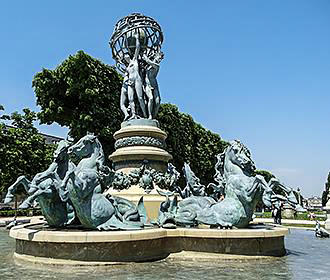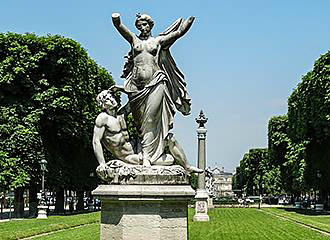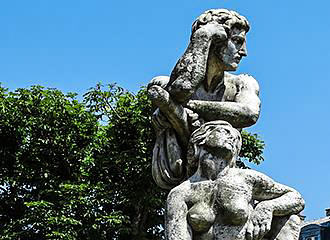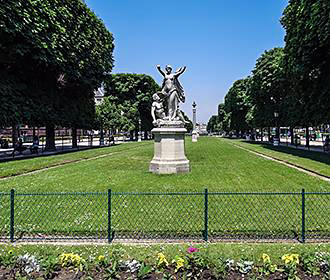Paris Jardin des Grands Explorateurs Gardens
This garden has a full name of Jardin des Grands Explorateurs Marco Polo et Cavelier de la Salle and was named after two explorers, but is has two separate gardens areas within it, now this was first laid out in the 1800s, however, the history of the area goes far further back to the 1100s, yet today you can discover statues and the famous fountain called the Fontaine des Quatre Parties du Monde, often known as the Fontaine de l’Observatoire or Carpeaux Fountain.
A bit of history
It was back in the 11th century that King Robert the Pious decided to build a castle on a plot of land outside the city limits of Paris, within a valley that was planted with vineyards, which was to become known as Vauvert, or Green Valley.
However, when the king died, the castle was abandoned, and then it became occupied by robbers, beggars and basically unscrupulous characters, with reports of screams often being heard from within, which gave it a reputation of being a castle of the Devil.
Then in the 1250s, King Louis IX gave the castle and land to Carthusian monks for it to become a monastery, and they became famous for their nursery gardens, that is, until the French Revolution, when the Carthusian monks were driven out and the castle was destroyed.
And so, in the 1790s the Jardin du Luxembourg reclaimed some of this land and they reserved the impressive nurseries, which can still be seen today, however the other part of the land remained abandoned for a few years until it was redesigned.
About the Paris Jardin des Grands Explorateurs Gardens
It was the architect Jean Chalgrin, who designed the Arc de Triomphe, that was instructed to do some renovations to the Palais du Luxembourg, the Medici Fountain and the gardens, and it was this architect who designed the perspective looking directly down from the Luxembourg Palace to the l’Observatoire de Paris.
Yet the Paris Jardin des Grands Explorateurs Gardens was not created until 1867, which was when the Avenue de l’Observatoire was created by Gabriel Davioud, and two different gardens were laid out on this stretch called the Jardin Marco Polo and the Jardin Robert Cavelier de la Salle.
But probably one of the most famous aspects of the Paris Jardin des Grands Explorateurs Gardens, is the monumental fountain called the Fontaine des Quatre Parties du Monde. However, this is also known as the Fontaine de l’Observatoire, which is why this part of the Jardin du Luxembourg is sometimes referred to as the Jardin de l’Observatoire, which is completely incorrect, as there is a small garden with this name right by the Paris Observatory, further down on the Paris meridian line.
Also within the Paris Jardin des Grands Explorateurs Gardens several Paris statues were added along the tree lined avenue, plus there are table tennis tables and plenty of park benches where you can sit and relax whilst admiring the beautiful flower beds or watching your young children in the playground.
Visiting the Paris Jardin des Grands Explorateurs Gardens
You will find the Paris Jardin des Grands Explorateurs gardens located within the 6th Arrondissement starting just past the southern exit to the Jardin du Luxembourg by the Esplanade Gaston Monneville, which was originally called the Square Cavelier de la Salle. This area was renamed after a former President of the Senate and a monument dedicated to him called the Monument to Gaston Monneville can be found here.
These gardens, known in short as the Jardin des Grands Explorateurs, then travel down to the Port Royal on the meridian line of the city, which passes through the Paris Observatory, with the garden nearest to the Luxembourg gardens being named the Jardin Robert Cavelier de la Salle and the one nearest the Paris Observatory being the Jardin Marco Polo.
It is open from morning until dusk, so the times do vary from approximately 8am through to around 5:30pm in winter, with it not closing until around 9pm in summer, and you may be pleased to know that the majority of the area is accessible to the disabled.
You can also find a water point for filling up your water bottles, and is a popular place to lay around on the grass in warmer weather or having a picnic.
Access to the Paris Jardin des Grands Explorateurs Gardens
The nearest Metro station is the Raspail stop serving lines 4 and 6, yet other modes of Paris public transport that will get you close by include the RER train station called the Port Royal stop serving the RER B line.
Alternatively, the Paris bus lines 38, 82, 83 and 91 along with the Noctilien Night Bus service via lines N01, N02, N14, N21 and N122 will also get you within walking distance, plus there are Velib stations for the self service bike here scheme located close to the Paris Jardin des Grands Explorateurs Gardens as well.



